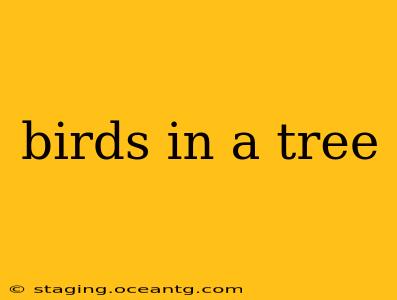Birds in trees—a seemingly simple image, yet one brimming with complexity and wonder. From the tiny hummingbird flitting amongst blossoms to the majestic eagle perched high above, the relationship between birds and trees is a fundamental element of our natural world. This symbiotic relationship provides a wealth of ecological benefits and offers endless opportunities for observation and appreciation. This article delves into the fascinating world of birds inhabiting trees, exploring their diverse interactions and the ecological significance of their presence.
What types of birds live in trees?
The diversity of birds that make trees their home is staggering, varying wildly depending on geographical location, tree species, and the season. Broadly, we can categorize them based on their nesting habits and foraging strategies. Some, like woodpeckers, actively excavate cavities in tree trunks for nesting and foraging insects. Others, like many songbirds, utilize existing hollows or build nests in the branches. Still others, like owls, may adapt existing cavities or build nests in dense foliage. The type of tree itself influences which birds you'll find—oaks attract different species than pines, for instance, due to differences in food availability and nesting structure. Coniferous forests harbor different avian communities than deciduous woodlands.
How do birds use trees for nesting?
Trees provide vital nesting sites for a vast number of bird species. The branch structure, foliage density, and height all play crucial roles in nest site selection. Some birds, like robins, construct cup-shaped nests using twigs, mud, and grasses, strategically placed in the fork of branches for stability. Weavers create intricate hanging nests, suspended from twigs, while others, such as woodpeckers, excavate cavities directly into the tree trunk. The location of the nest is crucial for protection from predators and exposure to the elements. Many species select sites offering camouflage and concealment, maximizing the survival chances of their offspring.
What do birds eat that live in trees?
The diet of tree-dwelling birds is incredibly varied and often closely linked to the tree's ecosystem. Insectivores, such as warblers and flycatchers, glean insects from leaves and branches. Woodpeckers use their specialized beaks to extract insects from beneath bark. Some birds, like fruit-eating pigeons and parrots, feed on the fruits and nuts produced by trees. Others, like certain owls, are nocturnal hunters preying on small mammals and birds that may also reside in or near the trees. Seed-eating birds, like finches and sparrows, may consume seeds found on the forest floor, but their presence depends on the trees' provision of seeds.
Why are birds important to trees?
The relationship between birds and trees is symbiotic; they benefit one another. Birds contribute to seed dispersal, facilitating tree reproduction by carrying seeds away from the parent tree. Insectivorous birds play a vital role in pest control, keeping insect populations in check and preventing widespread damage to trees. Their feeding habits influence the overall health of the forest ecosystem.
How do trees benefit birds?
Trees provide essential resources for birds, including shelter, nesting sites, and food. The foliage offers protection from predators and harsh weather conditions. The structure of branches and the type of bark support diverse nesting strategies. Fruit-bearing trees provide a reliable food source, especially during periods of scarcity. The ecological niches created within and around trees support the incredible diversity of avian life.
Conclusion:
The interplay between birds and trees is a testament to the intricate web of life within our ecosystems. Understanding this relationship allows us to better appreciate the ecological significance of both birds and trees, highlighting the importance of conservation efforts to protect these vital components of our natural world. Observing birds in trees offers a window into this dynamic and fascinating interaction, enriching our understanding of the natural world around us.
